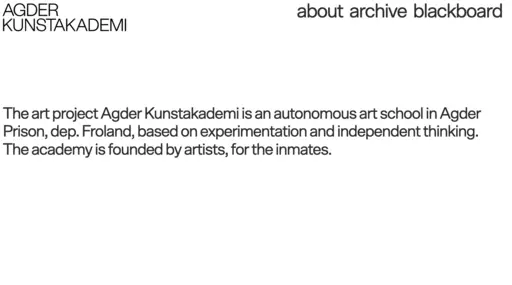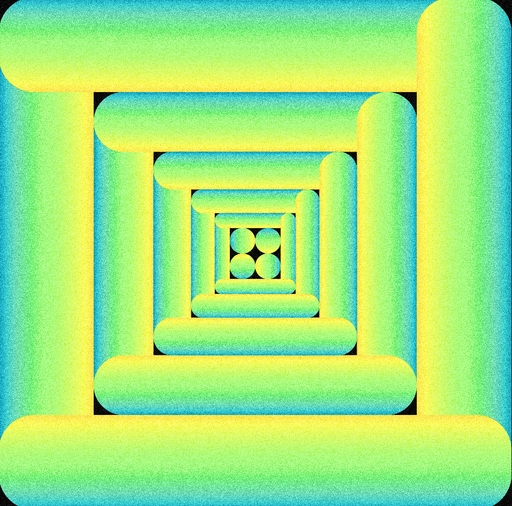
Thora Dolven Balke
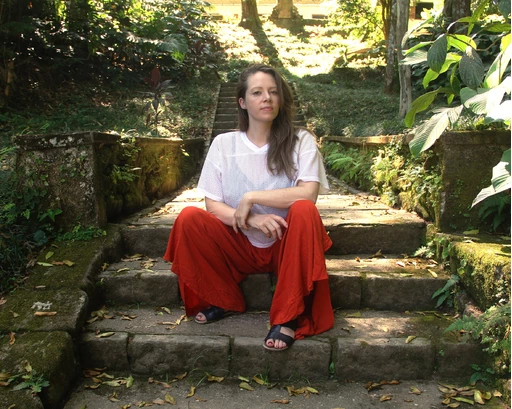
Thora Dolven Balke
Thora Dolven Balke is a Norwegian artist living between Oslo and Rio de Janeiro. In 2021, Thora and Kristine Jærn Pilgaard established Agder Kunstakademi, an art school inside Agder Fengsel, a high-security prison in Norway.
The Academy came about from one such project, after we met with the so-called ‘user group’ that is the representatives of the new building project who are a contact and discussion partner for the curators. This included Berit Johnsen, head of research at the University of the Norwegian Correctional Service, Jon-Erling Lystad, who was in charge of the building project, and Frank Tveiten Johansen, the prison director for this new model of prison, which at that time was not yet built. It is designed with wider corridors, bigger windows, spaces influenced by mental health research, choreography of movement and so on. The colour codes that they used for the whole prison, for example, are abstracted from three Edvard Munch paintings.
We came in at many stages of the building project—when it was just a hole in the ground, when it was built but still open and accessible, and then when security infrastructure was installed. So, when we first went into it as a building, we were walking around thinking, ‘wow, this is such an open and airy space!’ If you were to compare it to an educational institution, it was better than any I have ever been in in terms of the built space itself.
But the next time we were on site, all the security measures were in place. You had to pass through a seemingly endless number of doors; you had to pass through three layers of fences which had not been there the first time, so then of course the whole feeling changed. So, while you may still have huge floor-to-ceiling windows, it looks out on three layers of fences and always reminds you where you are.
Both Kristine and I have prior experience commissioning public art in prisons, especially projects with a social engagement, so we were very clear that if this commission were to go forward, it should be something that the inmates could use and be involved in. It wouldn’t be some work that has just been put there, which we like to joke could be like an extra punishment. Art as punishment. You have to live with it, you’re stuck with it.
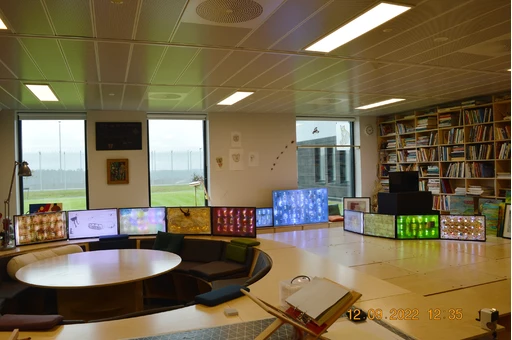
TDB: Exactly, or that the concept will somehow vibe with your situation. It’s complicated, right? Sometimes it works really well, but I’m sure that sometimes it can be pretty offensive.
So, we were adamant that it should be something that is shaped by the inmates, and we quite quickly came to the notion of a school. And it is important to note that we were founding a school from scratch. In a prison that was being built from scratch. We immediately started collaborating with Dag Erik Elgin and Hege Nyborg, two artists with long-term experience teaching and thinking about art-education and collaboration—in Norway and internationally—and invited them to consider a kind of ideal version of an art school in this context. Soon after, artist Sverre Gullesen joined the project and together we make up Agder Kunstakademi’s council, or board if you will. We ensure the quality of the programme and run all important decisions by each other.
It is also vital to point out that Agder Kunstakademi is a public artwork in itself; it is the staging of an art school, a collective social performance if you will, lasting three years and involving many artists. The result of that artwork is a physical and digital archive, and a collection of collaborative works made by visiting artists and students, installed in the prison as part of KORO’s collection.
As we have a generous budget, we could sort of just make our own project, and by extension or own educational platform, according to the ideals of people with intimate knowledge of institutions and teaching. In terms of accountability, this is a very unique project, as strangely, no one has ever sat us down and said ‘these are the rules you have to follow to start a school in a prison.’
Not only were we free to create whatever kind of institution we imagined, within certain physical and practical boundaries of course, we could make it responsive also to the specific needs of the inmates at any one time. We are not there with the mandate to rehabilitate, but we are there to say that this is ALSO a way that you can think. There are other ways to think of what prepares you to re-enter society after a sentence.
If you go into prison in Norway, you have to either work or study to earn the money that provides you with food, except of course if you are physically unable. You can choose between a range of fields and practices, and educational levels, but you’re obliged to choose something to fill your time with. This art school is one of a range of things they can choose from, as a full-time activity, alongside the other school programmes in prison which are organised by a high school in the region, through the municipality.
TDB: Actually, they can offer a range of degrees, but if we wanted to do that, then we would have had to conform to the same academic bureaucracy. You would have to have so and so many hours of specific requirements, and a grading system, and the prison director was very clear that ‘you have to be free of that. Art should be an autonomous space—be progressive.’
I found this interesting because other institutions of higher art education in Norway (speaking of the ones I know) have been becoming increasingly bureaucratised, and they have to conform to a lot of reporting systems and metrics of student performance. We have specifically been allowed to step away from that, which is very nice for everyone involved, but is also of course comes with its own challenges.
Today Agder Kunstakademi is a school with around ten students at any given time, who are inmates. They are in the classroom between 08.30 and 14.30 every day; those are the hours of the work/school day in prison.
SA: So, there is always a representative of security of some kind?
TDB: Yes. There is always a prison officer there, Solfrid Kjetså. It was our incredible stroke of luck that Solfrid applied to work in Agder Prison. She used to work in the film industry, but she decided that she wanted to do something different for a while and went into the criminal care system. She basically ran the whole school alone at first because we couldn’t get in during Covid lockdowns, and could only connect digitally. As the only person there every day, Solfrid had to negotiate between the students, give a voice and face to the programme and drive the critical discussions forward, and communicate with us and the prison administration. She had to figure out every issue around safety and accountability in the first six months as she was there in the everyday.
The Criminal Care system is obviously hierarchical, so Solfrid has people that she reports to, and a person directly above her who oversees all the workshops. This person then reports to someone who reports on to someone, who reports to the director. And then the inmates have other people keeping track of them. They have psychological care, they see a councillor, someone helps then identify what they should be doing in the prison. They have a lot of people to help and be in touch with. It’s an enormous bureaucracy. Saying that, the success of our project has been completely dependent on the individual people willing to think creatively within that system, give us room to experiment, and a green light to go forward.
But of course, when you open the doors to an academy for inmates, there is no one there who can advise and say, if you make art, these are the situations you should be aware of. I don’t think anyone had thought about potential challenges of these things before.
SA: You mean psychologically, for example?
TDB: Yes. But they have experience with similar situations when teaching other subjects. But when you study art, it can be somewhat different. Giving someone an autonomous and free space is a challenge, right? And art draws on personal experiences, which can be vulnerable.
It’s interesting because, having gone to art school myself, I have seen so much frustration from students who arrive seeking some sort of clear guidance, and who want some limits, because they are asking themselves ‘What is it I’m learning here? What is it I’m doing? What am I supposed to get out of it?’ You go into an education knowing you’re investing so much into it, but not knowing what you will get out. And that is the point, to be free of fixed and established metrics of progress, you have to find your own. That can be provocative for many students. For some it is perfect, and for some others it’s the worst thing that could happen to them. But here the school exists within a wider system that is governed to the smallest detail. So, this freedom of metrics comes against a completely different backdrop. It is a unique type of space within the prison ecosystem, something that is visible the moment you set foot in our very active, productive classroom today which feels like an artist’s studio.
SA: And do you have people across a wide range of ages and experiences in Agder Academy?
TDB: Very much. We have a big age range, from young adults to older ages. So, they have very different experiences, different backgrounds and knowledge that comes with it, and different levels of previous education. There are a number of factors that are interesting compared to a regular art school.
The first is that none of our students are there by choice exactly. They are there as a punishment that involves taking their freedom of movement and their agency.
So, while they have chosen to come to our art school, they are forced to be in the structure that they are in, which is itself a punishment, and, by its own logic, should be one. But the Norwegian criminal care system is focused on rehabilitation; that the work they do does not just apply to the time the inmates are inside, but should make sure they don’t come back. The prison direction has clearly expressed that they see the effect of an art education as part of this work.
And we have a responsibility of thinking into the future with our students, not just guiding them through the time they are in the academy but into life afterwards. Which is really nice, and of course is the aim of all education. Many of our students, however, are in complex situations for a range of reasons, which will bring specific challenges to life after prison. There is a lot going on outside of the classroom, which, again, there always will be in any school but here it can be more precarious.
SA: In most schools, though, there is an outside. You don’t all live in the same building.
TDB: And even if you do, you can get out and come back. Here you cannot. Some have been released during our project so far, and some will be staying for many years after we are done. This means we have other challenges in terms of responsibility because we want the school to be public, we want to promote it—not just because it is an art school, but because we think it could become a project for future reference. We want the school to do well because maybe art should permanently be part of the criminal care system.
SA: Also, if you are taking it seriously as an art education, a large part of how an art school works is by providing students and alumni a platform and credibility. Some kind of publicity. Without that credibility, not having the diploma or metrics means you don't have very much.
TDB: Exactly. This question of public platform and credibility is one of the places where it gets interesting and complicated. We have a huge responsibility to our students right to privacy, and to their freedom of speech. We have to discuss the issues that can arise when their work meets the public sphere, reactions by public or media to their personal biographies for example. How this can affect ongoing legal processes or family relations. One very clear decision we have made is that they are anonymised as students of Agder Kunstakademi while part of the project and its public iterations. Our principle is that every inmate is welcome at Agder Kunstakademi and we do not look into their backgrounds or sentences. We have decided to work in a high security prison and our role is not to judge. So, the public focus is not on individual stories or biographies. Of course, they are free to discuss their participation in the project as they wish.
SA: Do you have direct input from people about the legal frameworks you are operating within? Who can you ask for advice about letting one of the students publish their work? Like, if it affects a jury, or does this count as undue influence on a court case, or so on?
TDB: We actually don’t have this kind of direct source of advice, but we raised our questions with our collaborating partners in the prison because we felt that the main thing we don’t have experience with these kinds of ethical questions. We need a professional system around us to lean on because we don’t have the legal knowledge, for example. The prison director suggested that we make an ethics council, and that it should include students as well as professional within law, philosophy, art and the criminal care system. While we have not made a clearly defined board as such, we have created a group of people around us that are involved with the project and give us their professional advice. They, together with student representatives, will also be part of a public seminar during Agder Kunstakademi’s degree show at Kunstnernes Hus in Oslo in 2023, where a lot of these questions will be discussed.
I think in an art academy you can be clear in saying that a student should not put out into public a work alluding to sexual violence or inciting violence. The question for us, however, is if there is a reference to something we could miss. Can the people who have been affected by this specific case see it even if we don’t? How will it affect the victims? Their family? How will it affect the student themselves?
Media focus on a project like this could skew it in its entirety. A single story could come to represent the whole conversation. How do we deal with the media generally when there is so much hunger for sensational stories? And how do we prevent it from becoming a political tool in opposition to our own beliefs?
So, these are all questions that, when we have an ethics group, we can put it to them and discuss and decide together.
SA: Are they looking at adopting this as a structure for other programmes?
TDB: I don’t know about this specifically, but the prison is very keen to adopt the whole project and think how it is possible to extend it beyond our three years, and this is something we are focused a lot on this last year of Agder Kunstakademi.
In the prison, as in just about any institution, inmates have freedom of speech and can talk to the media. And we will never censor any artworks made here. But as in any school, we will have to discuss if there is some offensive imagery, and the prison can consider if there is something that could communicate criminal intent. But they give us complete freedom to publish works without screening them, so there is a trust there, and a responsibility. Having said all this, we have a very honest, good conversation with our students around this and greatly value their expertise and experience. So, we talk very clearly around these issues with them primarily.
SA: I am curious, who is there for you? Not just who is accountable for the students, but for you as course coordinators and staff?
TDB: As a teacher, you are often really alone with things, until someone maybe comes and assesses a conflict or so from the outside. We have a huge amount of monitoring because it is a prison. There are cameras in all spaces, everything is recorded. It was very important from the beginning to consider that the teachers, who we are sending into a very specific and potentially vulnerable situation, may come out and say, ‘wow, I heard something that I wasn’t ready for,’ or, ‘I didn’t want to hear that, or it triggered something in me.’ But here the collective is key: we have all signed non-disclosure agreements and so can share between ourselves. We make a point of debriefing together. In the beginning, we were thinking of having many more guest teachers and short courses, but it quickly became clear that it was important, and wanted, to bring people back several times. To build a relationship both ways.
We have had no bad experiences, and as soon as we met with the inmates, we realised that they create an atmosphere where they take care of each other and us in a very big way. There is a very strong group mentality of care. Solfrid has become an important figure for them and we do our best to be there for her. It’s a relationship that has its ups and downs, but I feel like our students have her back as well. Solfrid also has the prison direction, its regulations and HR department to lean on.
Before an artist goes into the school to give a course, we send them a document with a contact list, information that we are there, who is available for them. They have to sign a declaration of confidentiality, and they have their criminal records checked. In fact, most of the people that we need to decide things for us are outside our small project and its organisation, but in close collaboration with it. We are an institution within a bigger institution, and we have a kind of free, or flexible, space there. But we are governed by a bureaucracy whose focus is not art education.
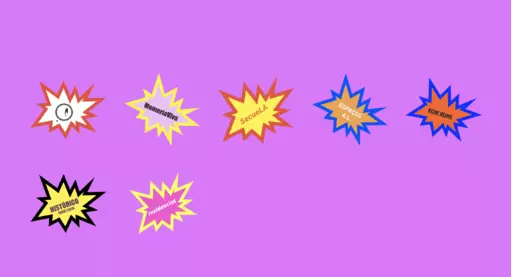
WEBSITE:
Capacete website
From 1998-2019, Capacete was a international residency programme and later an annual programme with 10-15 participants a year, dedicated to practice and research within arts and critical thinking, founded by Helmut Batista and under the direction of Camilla Rocha Campos from 2017-2019.
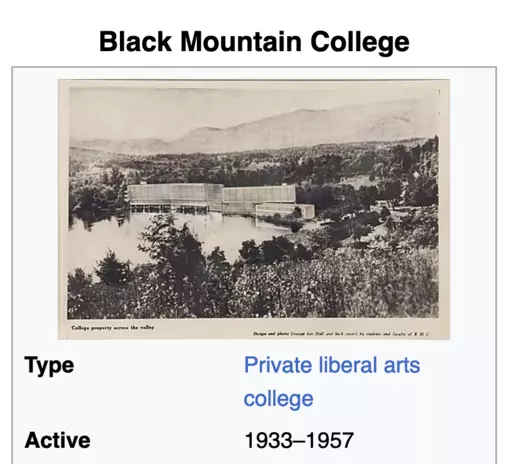
WEBSITE:
Black_Mountain_College
Black Mountain College was a liberal Arts College in Black Mountain, North Carolina, from 1933-1957. Experimental in nature and committed to an interdisciplinary approach. The school used non-hierarchical methodologies that placed students and educators on the same plane.
So, it’s interesting to me how you are able to identify in this situation where you have autonomy and where you don’t and where you can identify a maybe.
TDB: Yes, and you could say the same for the inmates because they have autonomy in creating what they want in our classroom but they are monitored. They know they have boundaries, their work is published, but we publish it, they don’t—although we have never rejected anything they have sent us for publishing.
Our intention with the academy council and ethics group is to make it possible to manage ambiguity. If there is a grey zone in anything we will take about it together and ask for advice. It’s positive for any institution to have that, someone from outside, giving council to students and staff on ethical issues.
In this case, even more than anywhere else, it’s clear when a student needs structures of help. They are in a situation here, though, where there is psychological support and monitoring. There’s legal help, there's medical help, and many people are constantly evaluating what the inmates need. Which is something that a regular student may not have. It’s something that, in some ways, many students might need.
But we have decided to insist on art as a free space within the prison, and to manage it by treating them like other students, but we are alerted to their needs if something happens. And even more than in other art schools we have had to make decisions about how to manage a situation ahead of time.
It’s good to have this conversation as we don’t have many people asking about the institution building element of the project. Because it is quite utopian and we want to make it as good as we can. It is more like an experimental art school, in that they always start with idealism, and then you don’t have any guidance really. And there are always going to be flaws in those visions that you discover on the way.
SA: I think it’s exciting in this case because it seems like so much of the framework is taken care of around you, which is not the case normally. You don’t know normally if someone comes in with a history of violence, you don’t have psychological evaluation for students or professors. But actually, this academy, in having a lot of the structure of safety very clearly built around you, raises the visibility of the same questions other schools need to address but in different ways.
TDB: Maybe you should at least have psychological support very clearly available in art school. I think there are always a few people in every class who would really benefit from that support, and having the tools that support can give.
Unlike a normal art school where you may come together for group critique occasionally, with us everyone is together in the same classroom all day every day. Solfrid therefore has to manage disagreements in this situation all the time. This is a huge part of prison life, just navigating and mediating potential conflict.
If there is an active conflict, the people involved may not be allowed to be in the same room. They may not even be allowed to be in the same building, and everything will be restructured to fit that situation. Prison life is really structured around managing this, and the inmates are very aware. They know they cannot have active conflicts while remaining in the programme, and then feel responsible for its continuation.
For example, the first guest teacher we invited, architect Alexander Eriksson Furunes, thinks a lot about tools of collaboration, planning and collective problem solving in his participatory work. His workshop with the inmates was foundational to Agder Kunstakademi in many ways, and it resulted in the architecture of our classroom. Through a series of conversations, they together identified the visible and invisible boundaries and possibilities that defined the space, thinking of the space in terms of communication and collaboration. Alexander then designed a new architecture for it based on their wishes and needs, a big piece of furniture with a circular sofa and meeting point, many work spaces and storage. Collaborative but with personal space. It was built in the prison workshop.
You can see it on the website; it’s like a building kit. It has barely any screws, it’s modular and changeable, and there is storage under in the floor which sets it aside from any other space in the prison in that you can shield things from view, have a private space. It is part of our previously mentioned collection of collaborative works that will stay in the prison, and it will be moved to Kunstnernes Hus in Oslo during the degree show.
This piece of furniture already sets the stage for how the students interact with each other and their ownership of our shared space. It is flexible and changeable, and that is also how we have wanted the project to be. The academy council meets regularly to discuss progress, to share our experiences and set the programme. It’s interesting because we have space and oversight to say what an individual student needs, or flag tensions that might be growing, if this or this form of education is not really working.
Arguably, we have this possibility much more than you do normally in a regular education.
